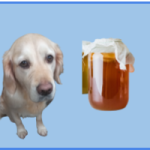
Do your dog’s ears give off a sweet musty smell? Does the poor thing lick his paws obsessively? Your pet might have a yeast infection.
Before you fly into a panic, remember yeast infections are quite common among dogs, and humans, unfortunately.
While such an infection might cause a lot of misery it is highly-treatable and the first remedy you should try is in that bottle of apple cider vinegar (ACV) sitting in your cupboard.
Here’s all you need to know about ACV, how to apply it to soothe your suffering pet and, also, when it might be time to see a vet.
Why do dogs get yeast infections in their ears?
Most yeast infections in dogs usually affect the ears, but your pet can also have it on his paws or skin.
Before addressing the why part, let’s see what yeast infections are. Yeasts are unicellular microorganisms that have been around for hundreds of millions of years. They’re a very large family, with over 1,500 different types, some of which are responsible for nasty itchy infections. Yeast are basically fungi and, under certain circumstances, can multiply rapidly. This is good when you’re baking bread, but not when the yeasts multiply uncontrollably on the skin.
When you ask yourself why your dog got that infection, you should keep in mind that it’s not like he caught it from some place. Yeasts are to be found on any healthy dog’s skin, together with thousands of other bacteria. In a healthy animal, these microscopic guys live in peaceful harmony and cause no harm whatsoever. Infections appear when something upsets the balance, allowing the yeasts to grow out of control.
As with humans, dogs are more liable to get yeast infections in the folds of the skin, such as the joints or the genital area. This problem is quite common among dogs with wrinkly skin or those with long floppy years. Yeast likes wet warm places, the perfect ground for them to multiply.
The breeds more prone to yeast infections are French Bulldogs, Shi Tzu, Shar Pei, Dachshunds, Poodles, Cocker Spaniels and many of the Terriers family. However, all dogs can get such an infection at some point in their lives, including puppyhood.
Common causes of yeast infections in dogs
When a dog develops a yeast infection, this means that something has upset the balance keeping the pesky microorganisms on his skin at peace. This can be caused by:
- Allergies
- Use of antibiotics
- Steroid treatments
- Underlying skin problems
Yeast Infection Symptoms
You don’t need a doctor to see your dog has a problem. If there’s a yeast infection it gives off of a musty smell, like old bread or your grandma’s attic. You might also notice a dark discharge in the ears or paws.
If the problem is with his ears, you will notice the red irritated skin. Since these infections are extremely itchy, the dog will lick or scratch the affected area until it bleeds, which is very dangerous as he might get a secondary infection. When the yeast infection has taken hold of your dog’s nether regions there’s going to be a lot of scooting on the floor or licking.
All these symptoms indicate the poor creature is looking for some relief from that terrible itch and this is where you can help right away.
What is Apple Cider Vinegar (ACV)?
As the name indicates, ACV is a type of vinegar which can be made of fermenting apple juice. During the first part of the production process, bacteria and, yes, yeast, are added to the apple juice to kick off the alcoholic fermentation process. Basically, the sugars in the juice are transformed into alcohol. Next step, another bacteria is added to turn the alcohol into acetic acid, that is vinegar.
How does Apple Cider Vinegar kill yeast?
ACV has been known for many centuries to have disinfectant, antimicrobial and antifugal properties, which is why it is a staple of traditional medicine. Usually, the concentration of acetic acid in ACV is somewhere around 5-6%. Acetic acid works by effectively killing bacteria and yeasts.
At the same time, ACV contains malic acid, commonly used in skin care products, as it helps remove dead skin and reverse the aging process. That is obviously not your main concern at the moment, but this malic acid helps restore skin health and promotes skin hydration. This is important as a healthy skin is not a breeding ground for yeasts.
Will white vinegar kill a yeast infection?
White vinegar is obtained by fermenting grains and has an acetic acid content of 4-7%. It also has antimicrobial properties and might be of some help for your pet’s problem, but is not as good as ACV when it comes to treating skin problems. That is because ACV is obtained through a double fermentation process rather than just one.
The point is that the bacteria used in the fermentation process for ACV is acetobacter aceti, popularly known as ‘the mother’. This ‘mother’ is made of good bacteria, aka probiotics, as well as enzymes which help digestion and have many other health benefits.
If you want to do yourself a favor, you should look for raw ACV. In most store-bought ACV products, the ‘mother’ is removed as it gives the liquid a murky appearance, which might put off customers. However, the best ACV is the murky kind and this would be the best product to use for your dog’s yeast infection.
How do you use ACV to kill yeast infections?
Although ACV is considered a weak acid, it’s still an acid and used undiluted might cause burns to your pet’s skin.
Before applying ACV, however, you should give your dog a bath to remove as much as possible of the yeast buildup and the crusts caused by the brownish discharge. If you go to a vet, the first thing they’ll recommend is an antifungal shampoo.
Your pet won’t object, hopefully, since the warm water itself will provide a bit of relief. Massage the shampoo into his fur, work up a lather and let the dog soak in it for a good 10 minutes.
Find something to distract the dog while you’re waiting, tell him a story, offer him a nice treat cut in very small pieces to last longer. Rinse the dog with plenty of water, use a big towel to remove most of the water and then you can proceed to applying the ACV solution.
This is simple to make, just use a 50/50 ratio of water and apple cider vinegar. If the yeast infection is in the dog’s ears, you could use a spray bottle so it’s easier to squirt it into the ear. When your dog has a problem in his paws, you should soak his paws in the diluted solution for some five minutes. Tell him another story if you have to, but make sure that you give the solution enough time to kill the nasty yeasts.
Keep in mind that even this diluted solution stings a bit, so avoid getting any in areas where your dog has scratched himself raw.
Once you’re done, don’t forget to dry his fur because, remember, yeasts love wet areas.
Are there any side effects of using ACV?
Apple cider vinegar is not toxic for dogs so even if he does manage to lick a bit off his coat it won’t cause him any problems. Just make sure it doesn’t get in their eyes and on the wounds he got from scratching.
An ACV and water solution can also be used on healthy dogs as a flea repellent.
Will ACV cure a yeast infection if a dog drinks it?
Probably not. There are many pet parents who give apple cider vinegar to their dogs, for the many health benefits ACV has, like stabilizing blood sugar levels or even weight loss. However, a dog can only have a teaspoonful of ACV in his water bowl and no more than a couple of times per week, otherwise it might cause stomach problems. Such a minute quantity is unlikely to have any effect on the raging yeast infection. It won’t kill the yeasts directly, but, on the other hand, boosting your dog’s immune system might prevent recurring infections.
What other home remedies might kill yeast infections?
After dousing your pet with an ACV and water solution, you should also apply coconut oil on the affected skin. Coconut oil is not only soothing, but it can help repair the damaged skin.
Tea tree essential oil can also be used to treat yeast infections, but you have to be very careful with that. Used at 100% strength, tea tree oil is poisonous to your dog even when applied on the skin. If the dog licks any of it, he might have a serious problem and there is no antidote for this type of poisoning. If you want to use tea tree oil, use a 0.1 – 1% concentration. That requires careful measuring and making sure to apply the solution only in places the dog cannot reach to lick himself. If you’re not very sure you can manage that, best stay clear of tea tree oil.
When should you let the vet treat an ear infection?
Ear infections are very tricky. First of all, the internal structure of the ear is very complex and you cannot be sure if you managed to squirt enough diluted ACV solution so it can reach the most hidden parts of the inner ear, where the yeasts might be hiding. Also, taking a careful approach and treating your pet with ACV solution over many days hoping it will work might put your pet through unnecessary suffering. Ear infections are very painful, your dog will be miserable and he might hurt himself by pawing or scratching at his ears.
There’s another problem, location. Any sort of infection in the head area can lead to complications, since they’re so close to the brain.
Our advice – try the ACV solution on the ears for a day or two, but if you see no improvement, go see the vet. Most drugs come with a whole range of side effects, but in this case this might be the safest choice.
Closing Thoughts
Yeast infections are very common in dogs and they can affect many areas: the ears, the paws, the genital or anal area. Yeast infections can also develop in the skin folds. If you notice a rash, itchiness, a musty smell or a dark discharge, it’s quite possible your dog has a yeast infection.
This can be treated at home with a water and apple cider vinegar solution. However, if you don’t see any improvements in a couple of days, you should take your dog to the vet.






